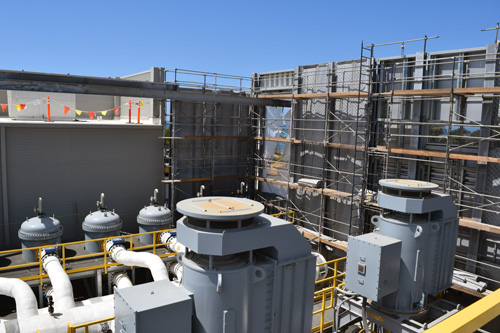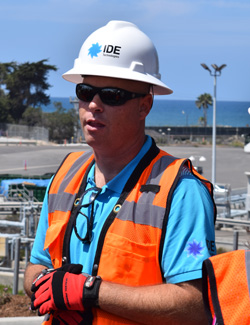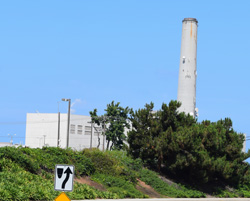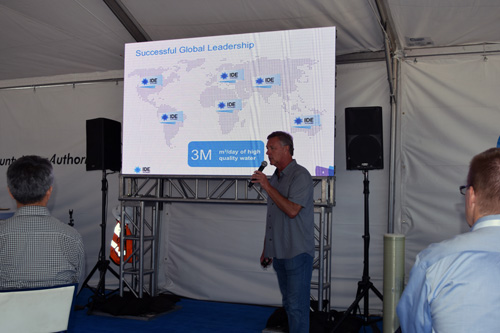
By Donald H. Harrison


CARLSBAD, California – Within a matter of months, most probably before the end of the 2015 calendar year, the San Diego County Water Authority will receive 50 million gallons of fresh water each day from the new $1 billion Carlsbad Desalination Plant and pipeline that was financed by Poseidon Water and built and operated by the Israeli company IDE and other contractors, according to officials.
Project manager Ziv Shor from Kfar Yonah, Israel, said on Wednesday, Sept. 2, that the Carlsbad desalination plant already is processing between 100 million and 108 million gallons of seawater a day. After being put through various kinds of chemical treatments and cleansing filters to remove particulates, the water is pumped through a large, dense, reverse osmosis (R.O.) array that eliminates the salts, making the continuously-tested water drinkable.
In that the plant is awaiting final testing and official commissioning, all 108 million gallons of water are daily pumped back into the Pacific Ocean where the seawater originated. Once the plant is given the official go-ahead to operate, half of that water – up to 54 million gallons – will be pumped daily into a 10-mile long, 54-inch diameter pipeline to be mixed at the San Diego County Water Authority’s (CWA) second aqueduct. From there the desalinated seawater will be pumped by the CWA to its Twin Oaks Valley Treatment Plant for further treatment and mixture with water that the CWA obtains from such other sources as the California Water Project and the Colorado River.
Meanwhile, the other 54 million gallons of the Carlsbad plant’s water will be mixed with the salts and particulate residue that had been filtered out of the seawater to be sent back to the ocean.
Officials say the desalination plant will be able to provide between 48,000 and 56,000 acre-feet annually, enough to serve 112,000 typical single-family homes, or approximately 7 percent of the region’s anticipated water demand in the year 2020.
In giving a tour to delegates of the International Desalination Association convention, which had met in downtown San Diego, IDE emphasized that flexible technology often is required in order to adapt desalination processes to the requirements of the site.

In the case of the Carlsbad plant, they pointed out, water is not taken from the ocean directly, but rather is taken from the cooling water used at NRG Energy’s Encina Power Plant, which sits on the Agua Hedionda Lagoon, adjacent to the desalination plant. The Encina Power Plant uses over 300 million gallons of seawater daily to cool its power generating station. From there, some of it is pumped up to the desalination plant, while the rest is returned to the ocean. In a couple of years, the Encina Power Plant will be replaced by a new plant nearby, requiring new connections for pumping to be constructed.
Shor said that because the Carlsbad coast, like many other coasts around the world, is subject to periodic “red tides”– a condition also known as algal bloom–the R.O. array meets rigorous design specifications to filter out the microorganisms.
The Carlsbad Desalination Plant sits on only 6 acres of land – tiny compared, for example, to the 100 dunams (approximately 27.4 acres) required for Israel’s Sorek Desalination Plant, which produces 624,000 gallons of fresh water daily. That plant is located about 15 kilometers south of Tel Aviv. Even so, by virtue of its output, the Carlsbad facility is the largest desalination plant not only in the United States but in the Western Hemisphere, officials here say.
Taking a tour group clad in helmets, safety glasses and vests through the Carlsbad site, where final touch construction continues, Shor pointed out that instead of lying horizontal on the ground, many of the pumps sit in a vertical configuration—one of the ways in which engineers were able to fit so much machinery in such a small space. Just in instrumentation alone, said Shor, there are approximately 1,000 unique pieces.

In a general orientation, Mark Lambert, the CEO of IDE Americas, said IDE has built some 400 water facilities around the world, enough to produce 3 million acre feet a day of fresh water. Given that California is suffering a drought, and most of San Diego County’s water has to be imported from elsewhere, utilizing water from the ocean is a practical, drought-proof solution to Southern California’s water needs.
After certification, IDE will operate the Carlsbad Desalination Plant for 30 years under its contract with Poseidon , Lambert said.
*
Harrison is editor of San Diego Jewish World. He may be contacted via donald.harrison@sdjewishworld.com
Pingback: Israeli partnerships proposed for water, cyber security - San Diego Jewish World
Pingback: 'Let There Be Water' relates how Israel got it - San Diego Jewish World